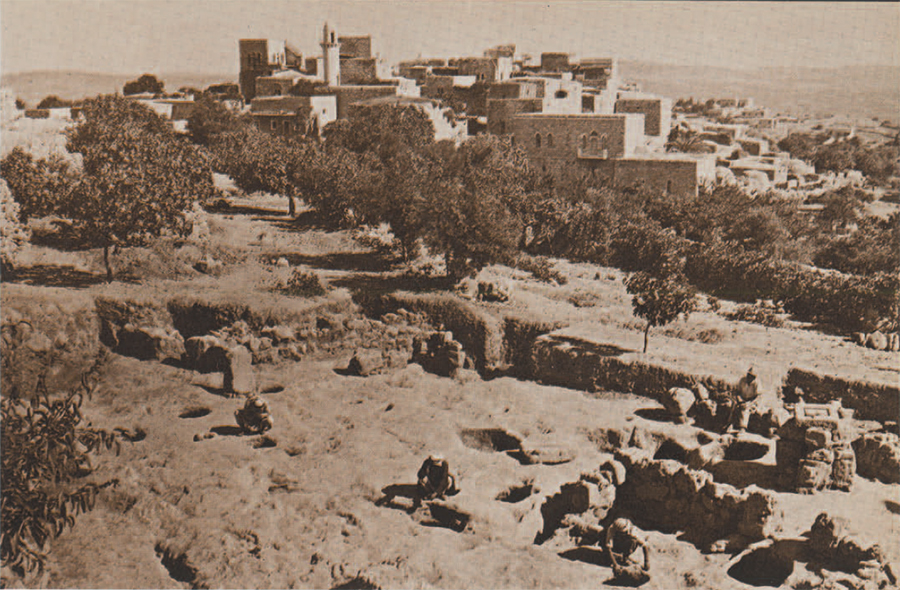
In a Near Eastern country such as Jordan an archaeologist learns quickly that it is usually best to discount, if not disregard completely, local rumors about ancient wonders which lie underground. Too often these alleged treasures have been found to exist only in hear-say embroidered by folk imagination. Yet, what seemed to be a highly improbably tale supplied the clue for the most important discovery of the University Museum’s 1959 expedition at ancient Gibeon: a 2600-year-old winery, perhaps the oldest yet discovered.

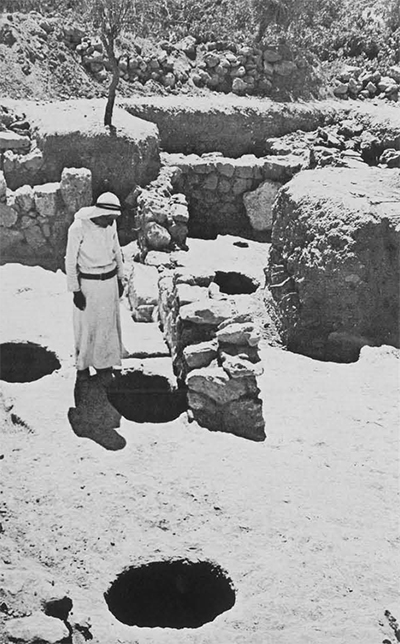
After we had worked for two months at el-Jib, the modern village which is the site of biblical Gibeon, Hassan Abdullah, an elderly laborer, told me a story to which I had listened patiently, but skeptically, on two previous campaigns. Some sixty years ago, Hassan alleged, someone had found a great pit in his field, and on descending into it had discovered a cave to which there was a sealed door. Asserting that the story was true “by Allah,” Hassan urged me to rent his field for excavation.
By chance, on the very day of Hassan’s third recital of this story we had ten workmen and a supervisor who had finished their plot and had nothing to do. Why not, I thought, put an end once and for all to this improbably tale? Hassan and another villager, whose memory reached back sixty years, solemnly pointed to the spot at which the pit had been seen. We rented the land, staked out a plot of twenty-five square meters, and began to dig.
To the amazement of everybody, except Hassan Abdullah and his aged friend, we soon struck the opening to a pit, which produced the most important link of evidence for the identification of a large industrial installation as a winery of the seventh century B.C. and, indeed, there was a door, not to a cave, but to a Roman tomb containing elaborately decorated walls and a columbarium with funerary niches for approximately two hundred burials. Needless to say, Hassan received a generous reward for his story.
El-Jib is a large mound which lies in the middle of an open plain just eight miles north of Jerusalem. In 1956 we had been able to identify the place by finding some labels to wine jars containing the name Gibeon, which is rich with biblical association. It is related that the Gibeonites deceived Joshua and got from him a covenant of peace, so that their city escaped destruction which Joshua was accustomed to inflict on cities like Jericho and Ai which were in his path. The men of King Saul fought the men of King David at the “pool of Gibeon.” Later, Solomon made use of the city’s ancient “high place” for sacrifice before he built the famous temple in Jerusalem. But for the four centuries from the time of the erection of Solomon’s temple to the Babylonian exile, the historical records of the Old Testament are silent with regard to the fate of this important city.
As a result of our work in the summer of 1959 it is now evident that in the four centuries of Gibeon’s “Dark Ages,” the Gibeonites were busily engaged in trade and commerce. During this long period the city was protected by a great wall fourteen feet thick which encircled its sixteen acres of buildings–one of the largest walled cities of central Palestine. The failure of the religious history preserved in the Bible to mention the activity of this thriving metropolis over a period of four hundred years is obviously due to the fact that after the early years of Solomon’s reign it no longer served as a religious shrine. The writers of the Old Testament were more concerned with religion than with industry and commerce.
Four years ago the University Museum expedition to el-Jib discovered a large pool which had at its bottom a stairwell leading down to a spring of water which flowed through the rock 82 feet below the street level of the city. In order to insure a supply of water within the city when the gates were shut in time of siege, the ancient Gibeonites had quarried and removed about three thousand tons of solid limestone for the making of the famous pool. They had cut a circular stairway of 79 steps for the water carriers to reach the spring. The tradition that the men of Gibeon were “carriers of water” has been preserved in Joshua 9:21.
Much of our effort in the first two seasons of 1956 and 1957 was devoted to removing the debris which had been filled into this rock-cut pool. The most interesting remains consisted of fifty-four handles from wine jars, each with the name and address of the maker of the wine. The address, Gibeon, was followed by such well-known biblical names as Azariah, Amariah, Hannaniah, and others. But where did these jars come from? How was wine made and stored in ancient Gibeon? How extensive was this wine industry at Gibeon which obviously produced a supply sufficient for export? These were some of the questions that we hoped to answer when we began a systematic clearing of the area around the pool which had produced the firs clues for the industry.
During the first weeks of the 1959 excavation* we discovered just north of the pool a large open area, the size of a small city block, without any house walls. When we had cleared it down to bedrock, there appeared eleven vats, roughly bell-shaped, hewn out of the rock. The opening at the top was usually small–the average was 29 inches–and could be covered over with a flat slab of stone. Some of these were found in place. Below the mouth of the vats the cutting had been enlarged to a diameter of 6 feet and the depth averaged 7 feet 4 inches.
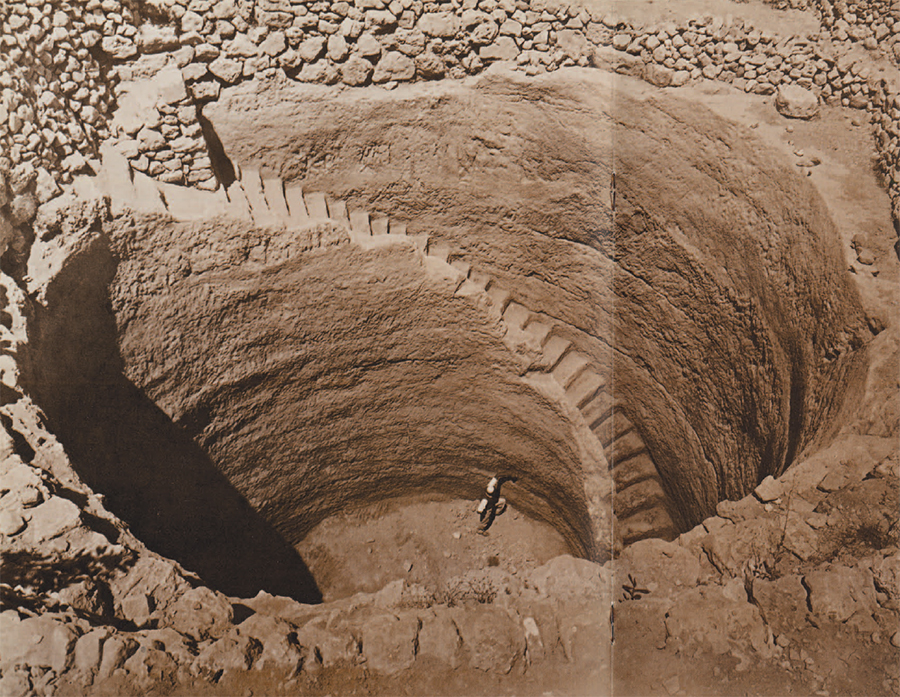
What purpose could these carefully cut vats have served? To judge from the damp debris which came from them they would not have been suitable as silos for storing grain, since it would have moulded quickly. Nor could they have been intended for water, as they were much too small for this purpose and there were no channels cut into the rock for conducting water into them. But to make certain that they had not been cisterns we hired a man and a donkey to carry water from a well two miles away to fill one of the vats. In three days’ time all the water had seeped out through the porous limestone walls.
The result of this experiment also excluded the possibility that other liquids, such as oil or wine, could have been stored for any considerable length of time in the pits. We made one final effort to find out if we could determine what product had been made and stored in this area. Scrapings from the walls and bottom of each pit were collected and sent to the government laboratories of the Hashemite Kingdom of Jordan in Amman. The analysis proved that the organic matter within the vats was approximately the same as that in the local soil and could not be distinguished from it.
It was only during the final three weeks of the season that we found the clue for identifying Gibeon’s industry. It lay buried in the very place which Hassan had finally persuaded us to dig. Here we found an even larger industrial area, on in which the bedrock was literally honeycombed with vats similar to those in the area to the north. There were twenty-seven by actual count.
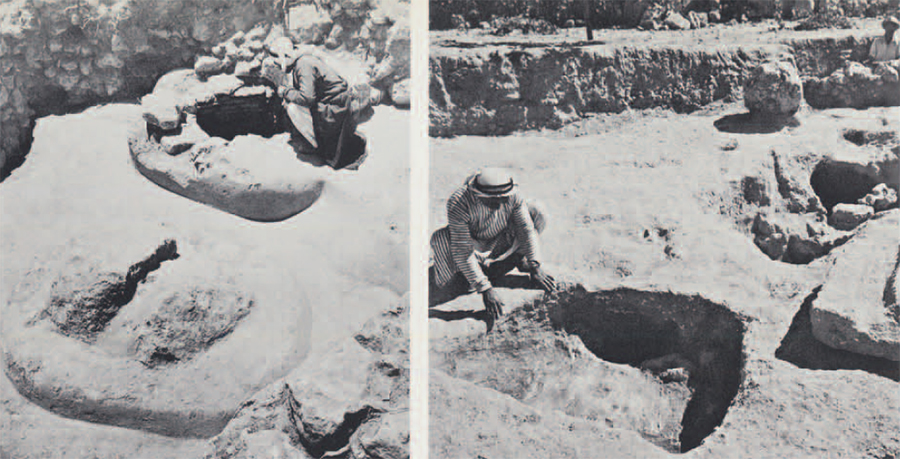
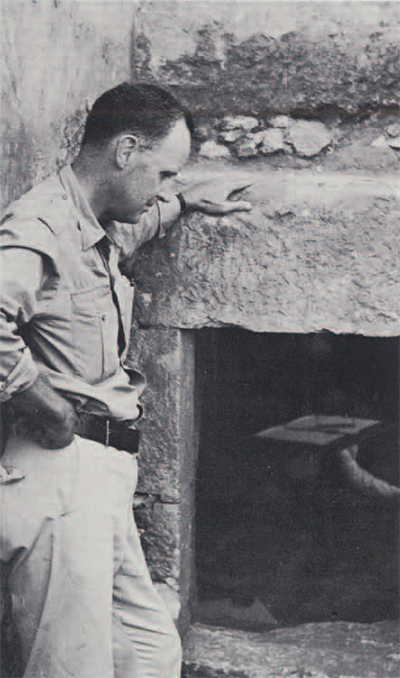
In one of these there appeared hundreds of fragments of storage jars, all of them of the same type; but unfortunately the jars had been so completely broken to bits that not one could be restored to its original shape. But in another bell-shaped vat, which had been capped by a large stone for 2600 years there appeared a whole jar of the same type lying on its side at the bottom. It was then clear that the vats had been cut as cellars for the storage of jars, most probably containing wine that could only there have been kept at a constant temperature of 65 degrees Fahrenheit during the late summer heat of Palestine. Upon making a trip to the nearby winery at Latrun we found that today wine is stored there at the same temperature in underground vaults.
At the end of the eleven weeks of work the bits of evidence collected over three seasons began to fit together. Thirty-eight cellars, with a total capacity of 40,000 gallons, provided for the vitners of Gibeon the best refrigeration possible for the wine which had been pressed by foot in large treading basins. In these cellars it would have been possible to store jars containing at least thirty thousand gallons of wine. Wine which was was to be exported was transferred from the large storage jars, holding eight to ten gallons, to smaller ones which could be transported more easily. These were labeled with the name and address of the makers so that empty containers could be returned for the proper credit or refund. Within the cellars there were found a number of funnels which had obviously served as equipment in the wine industry. it is interesting to note that “wine cellars” are actually mentioned in the Old Testament in I Chronicles 27:27.
But how could these labeled wine jugs have been sealed to keep the wine from souring? A number of clay stoppers turned up in the excavation. While these fitted neatly into the mouths of the wine jars, they could not possibly have provided the air-tight seal which is required to keep wine from spoiling.
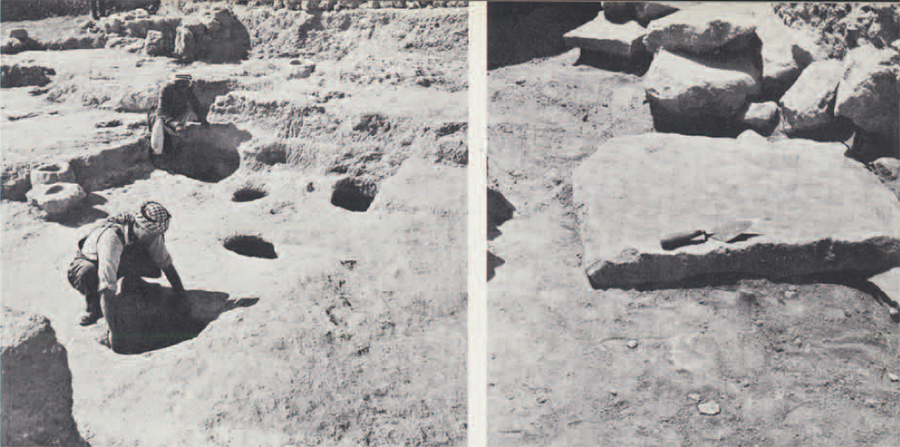
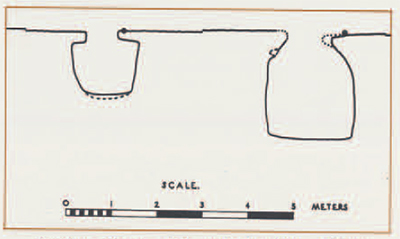
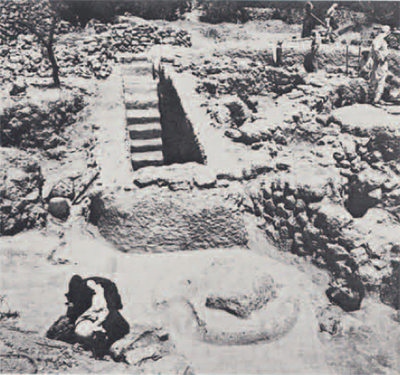
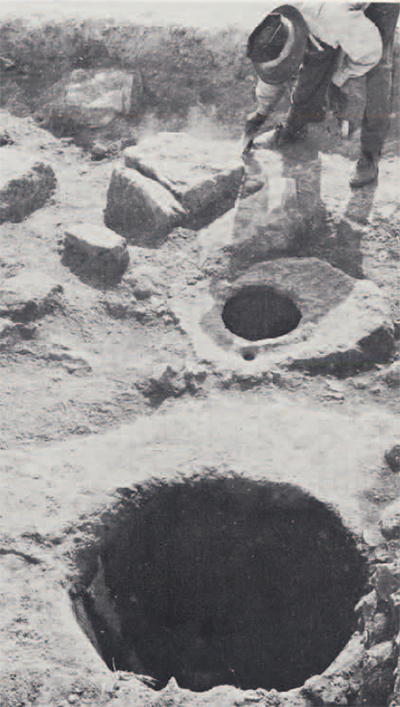
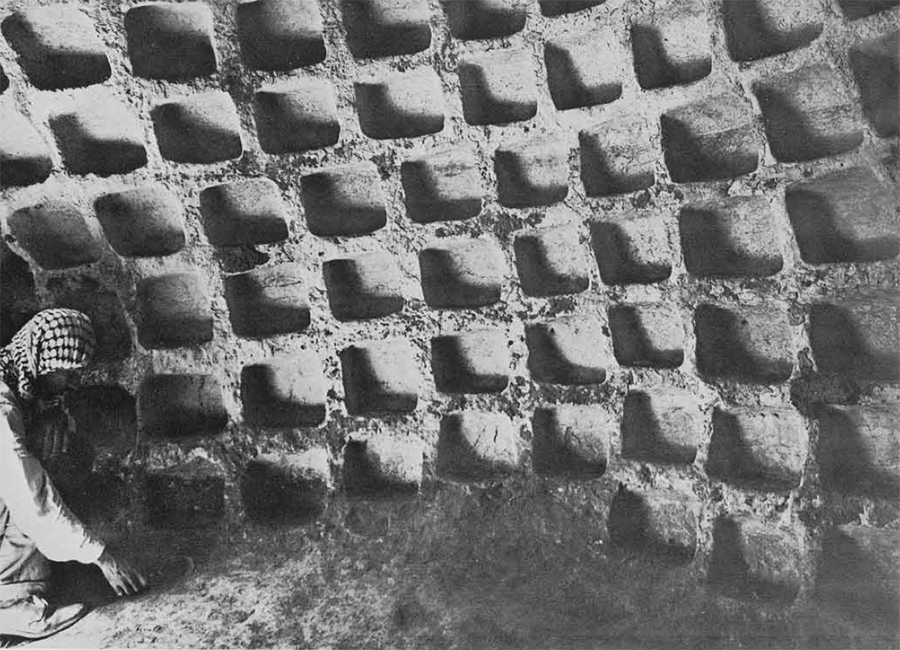
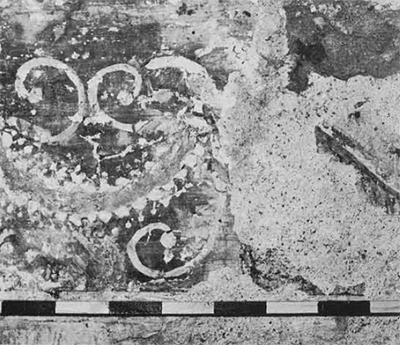
A wine maker at the nearby Trappist Monastery at Latrun suggested that olive oil poured on top of the wine would seal it completely from the air. We purchased two bottles of local wine, opened them both, and poured an inch of olive oil into the neck of one bottle. After a month we found that the oil had preserved the wine in the one bottle while the other opened bottle of wine had spoiled. It then became clear that olive oil–there were two presses for olives found in the industrial area–could have filled the high, narrow neck of the wine jar to provide an excellent seal for its contents. The stopper then would have prevented the contents from spilling.
During the third season of excavation at el-Jib much was learned about the long history of occupation at Gibeon. We cut through five main levels of occupation to recover the history of the city over a period of 3300 years.
Gibeon was a great city about two thousand years before it was mentioned in literary sources. It was first occupied in the Early Bronze Age, during the first half of the third millennium B.C., when a large part of the mound was built over. As yet, we have not been able to trace the city wall of this period, but on the north side it is clear that it lay outside the later Iron Age wall. That this first phase of occupation came to an end through a violent destruction is apparent from the remains of a room in which there were more than a dozen jars which had been crushed by the collapse of the roof.
The site remained virtually unoccupied until the eighteenth century B.C., when it was again settled for a brief period of two or three centuries. Although a considerable amount of pottery has appeared from this second period of occupation on the west and the north of the site, no house walls or floor levels have as yet been distinguished.

At the beginning of the Iron Age, about 1200 B.C., Gibeon was resettled. It seems probably that it was first encircled by a city wall which was 11 feet in width, built on the edge of the rock scarp of the natural hill. Later in the Iron Age the city was enlarged by the moving of the city wall outward on the north so as to include a larger area, and the water resources were increased by the cutting of another tunnel which ran from inside the city wall through the rock of the hill to the most copious spring which flows from the base of the mound. To judge from the wear on the 93 steps of this tunnel, the later hydraulic installation was much more successful than the earlier, more ambitious cutting of the pool and stairwell, where the steps display little evidence of wear.
In the Iron II Age the city reached its peak of prosperity. In the eighth and seventh centuries it was a thriving commercial center. Something of its economic importance is indicated by a total of 95 stamped jar handles which have already been found; 88 of them bear the royal stamp and seven various private stamps.
Following the destruction or abandonment of the city at the end of the seventh century the evidence for occupation during the Persian period consists principally of a gold ring which had been dropped into a crevice of the demolished Iron Age city wall, a silver ring inscribed with the letters I m r t sh m n, and five msh stamps on handles.
During the first century B.C. there was a considerable settlement at Gibeon. The great pool and stairwell were filled in. Plastered basins were made for baths. Some of the vats of the once thriving wine industry were left covered over or were plastered and reused as cisterns. Others of them were enlarged during the Roman period and used for a columbarium and for an elaborately decorated tomb.
One very promising area for excavation was a large field free of trees and houses on the highest part of the hill. Could not this have been the site of the “high place” at which Solomon is reported to have sacrificed? On digging here we found no ancient walls but only fragments of ancient pottery in a most puzzling stratification. Near the surface was pottery of the Early Bronze Age and below it fragments from a period two thousand years later. After we had cleared about five feet of soil from this area we found a clear answer to the confusion in the evidence. A three-inch unexploded British shell and Turkish gun emplacements made it clear that this was the place in el-Jib where the Turks had held out for six weeks against the attacks of the British army during Allenby’s campaign for Jerusalem. Thus the latest occupation robbed us of valuable evidence on an important part of the ancient biblical city.
